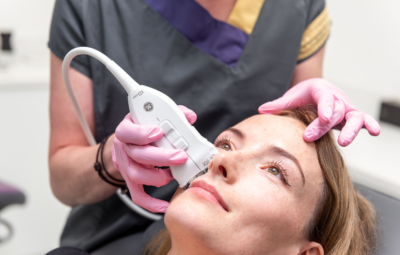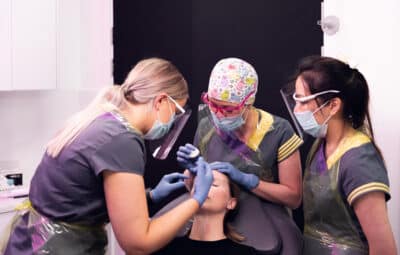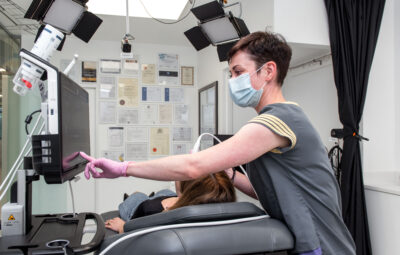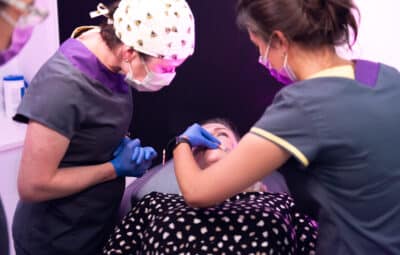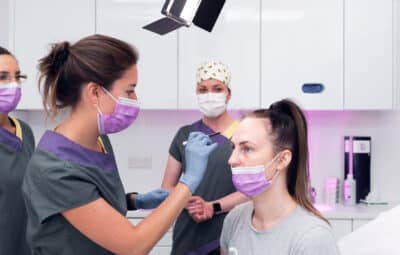
Facial Assessment: The Scientific Approach to Aesthetics
8 April 2025
In this post:
- Facial assessment is the foundation of safe and effective aesthetic treatments, combining an understanding of anatomy, proportions, and patient goals to avoid poor outcomes and guide precise treatment planning.
- A comprehensive assessment relies on three pillars: a detailed consultation to uncover patient needs and readiness, diagnostic records for objective analysis, and a hands-on clinical examination to evaluate soft tissue, muscle tone, and bone structure.
- Golden ratios and established aesthetic principles—such as the rule of thirds, rule of fifths, and profile assessment lines—guide facial harmony.
- The best way to learn how to conduct facial assessments is through structured training that ensures practitioners develop the expertise to deliver safe, beautiful results.
In aesthetic medicine, the difference between a safe, effective treatment and a risky one often comes down to the facial assessment conducted before the needle hits the skin.
At the Smileworks Aesthetic Training HUB, we believe no practitioner should treat a patient without a thorough understanding of facial anatomy and proportions. This understanding informs what treatments, dermal filler types, and techniques are suitable for each individual patient.
In this post, we’ll dive into how to conduct a comprehensive facial assessment and why this pre-treatment analysis is essential for ensuring a safe result for your patient. This skill is the foundation upon which all jaw-dropping results are built.
The above video is a clip from our Essential Practice course. To view the rest of the video and access the full course, enrol today!
What Facial Assessment Matters
Have you ever wondered why some people are considered objectively more beautiful than others? Or why certain aesthetic treatments look natural while others don’t? There’s a reason why a person like Angelina Jolie is considered universally attractive. The answer lies in facial assessment – a scientific approach to understanding beauty.
Since the Renaissance, artists and scientists have been establishing rules that define facial attractiveness. These aren’t just arbitrary standards but rather mathematically determined proportions that our brains naturally perceive as beautiful.
When aesthetic treatments go wrong, it’s often because the injector failed to properly assess the patient’s face and violated these foundational principles. The UK’s aesthetic industry is notoriously unregulated, so unfortunately treatments go wrong more often than you think. The key to successful treatment planning starts with a comprehensive, accurate assessment. Get this right, and you’ll create predictable treatment plants that achieve remarkable results.
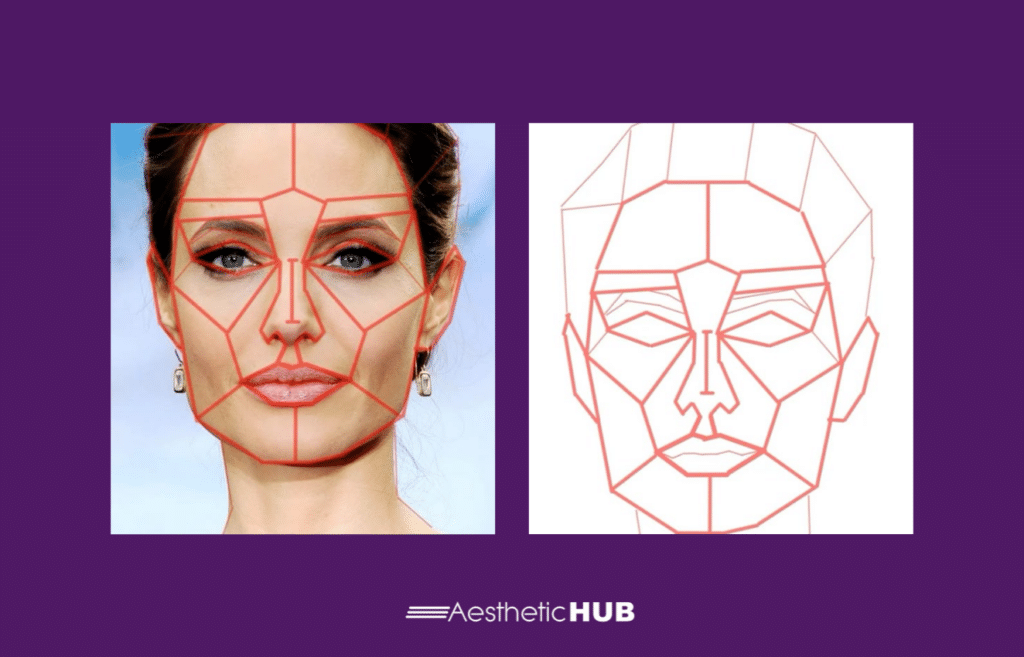
The Three Pillars of Facial Assessment
A comprehensive facial assessment requires meticulous attention to detail and rests on three essential pillars.
1. The Consultation
The consultation is your opportunity to understand not just what your patient wants, but what they need. During this crucial first step, you will:
- Listen carefully to your patient’s concerns and desired outcomes
- Observe their facial expressions during conversation – this reveals dynamic aspects of their face that static assessment might miss
- Discuss their aesthetic goals and help them articulate what they find beautiful
- Assess their psychological readiness for treatment and manage expectations
- Establish a rapport that enables honest communication about realistic outcomes
Remember that may be clinically correct may not align with your patient’s aesthetic preferences. The consultation bridges the gap between objective assessment and subjective desires.
2. Diagnostic Records
Proper documentation through high-quality records is non-negotiable for effective facial assessment:
- Standardised photographs from multiple angels (frontal, profile, three-quarter, and dynamic expressions)
- Consistent lighting and positioning to ensure accurate evaluation
- Digital measurements to document proportions and asymmetries
- Before and after photo comparisons to track treatment progress
- Clinical notes for documenting specific areas of concern
These records serve as both diagnostic tools and legal documentation. They allow you to study the face objectively and communicate findings clearly to patients.
3. Clinical Examination
The hands-on clinical examination reveals what photographs cannot, including:
- Tissue quality, elasticity, and thickness
- Muscle tone and strength through palpation
- Bone structure beneath soft tissues
- Vascular patterns and danger zones
- Skin quality, texture, and laxity
A thorough clinical examination combines visual assessment with tactile evaluation. By understanding the patient’s unique facial architecture, you can create treatment plans that address structural causes rather than merely treating symptoms.
These three pillars – consultation, records, and examination – must work in concert. One without the others will not yield optimal results. Together, they form the foundation for evaluating the three fundamentals aspects of facial aesthetics: morphology, balance, and symmetry.
Facial Balancing: The Mathematics of Beauty
Facial balance isn’t simply about symmetry. It’s about the harmonious relationship between facial features according to established proportions. As medical professionals, you’ll find these mathematical relationships strikingly similar to the golden ratios used in dentistry and other medical specialties.
Vertical Proportions: The Rule of Thirds
The ideal face divides into three equal vertical segments, each playing a critical role in overall facial harmony.
Upper Third (Trichion to Glabella): This section encompasses the forehead from the hairline to the point between the eyebrows. A proportionate upper third creates balance and frames the eyes properly. In aesthetic medicine, volume loss in the temples or forehead height discrepancies often require correction in this zone.
Middle Third (Glabella to Subnasale): This section includes the eyes and nose. The middle third is crucial for facial expression and often is the first area to show signs of ageing. Assessment should include intercanthal distance (distance between the eyes), nasal length, and nasal projection.
Lower Third (Subnasale to Menton): This section extends from under the nose to the chin and can be further subdivided into upper and lower segments:
- The upper segment (subnasale to stomion/lip junction) should comprise approximately ⅓ of the the lower face
- The lower segment (stomion to menton) should comprise approximately ⅔ of the lower face
Vertical disproportion is when one third is significantly longer or shorter than the others. This often requires a multi-modality approach to correction. For example, a diminished lower third might benefit from chin augmentation rather than just lip enhancement.
Ideal measurements include:
- Total face height to width ratio: 1.35:1 for males and 1.3:1 for females
- Bizygomatic width (measured between the cheekbones): approximately 70% of total vertical face height
- Lower face height: typically 55-57% of the middle and upper third combined
Horizontal Proportions: The Rule of Fifths
The rule of fifths divides the face horizontally into five equal sections, each approximately the width of one eye. This assessment helps identify transverse discrepancies that might otherwise be missed:
- The distance from the outer corner of one eye to the outer corner of the other eye should equal three-fifths of the total face width
- Each fifth should be approximately equal in width, creating balance across the face
- The outer fifths (from ear to outer eye) should be equal on both sides
- The central fifth should align with the width of the nasal base
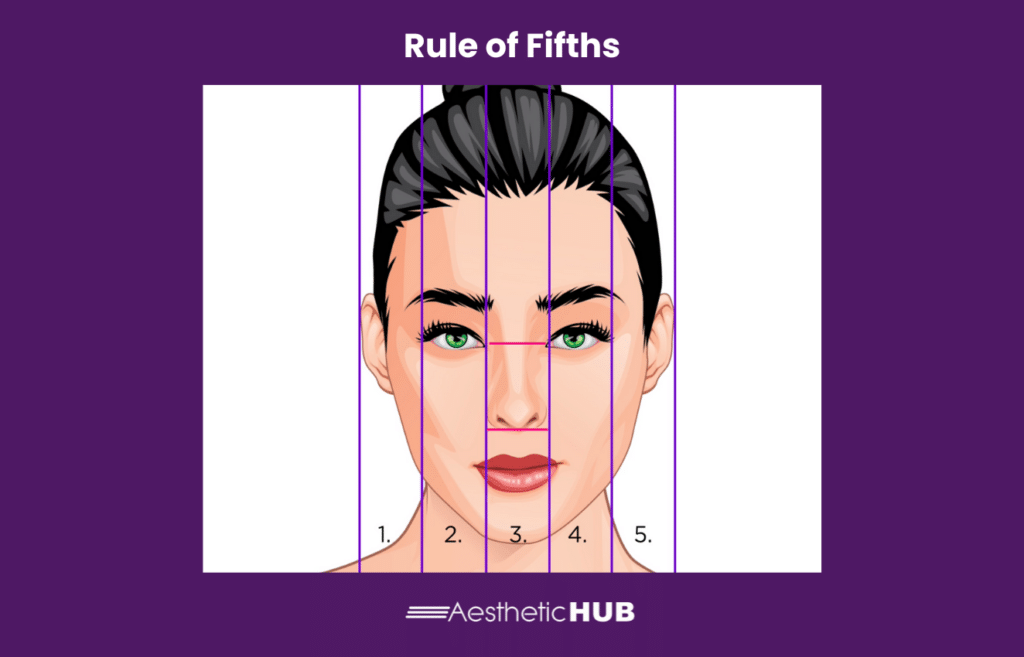
Additional horizontal measurements to consider:
- Bitemporal width (measured at the temples) should be approximately 80-85% of bizygomatic width
- Bigonial width (measured at the angles of the mandible) should be approximately 70-75% of bizygomatic width
- The alar base width (widest part of the nostrils) should equal the intercanthal distance (between the inner corners of the eyes)
- Mouth width should ideally match the distance between the medial borders of the iris when looking straight ahead
- Philtrum width should be approximately half the width of the nose at its base
These measurements provide objective parameters for assessment, but remember that ethnic variations and individual features may necessitate deviation from these standards.
Profile Assessment: The Skeletal Blueprint
The profile view reveals the anteroposterior (front-to-back) relationships between facial structures that frontally appear normal. A comprehensive profile assessment includes:
Skeletal Classification
- Class I: Considered ideal, with the maxilla and mandible in proper alignment. The true vertical line runs through the nasion, subnasale, and pogonion points.
- Class II: Characterised by mandibular retrognathism (recessed chin) or maxillary prognathism (protruding upper jaw), creating facial convexity.
- Class III: Features mandibular prognathism (protruding chin) or maxillary retrusion (recessed midface), creating facial concavity.
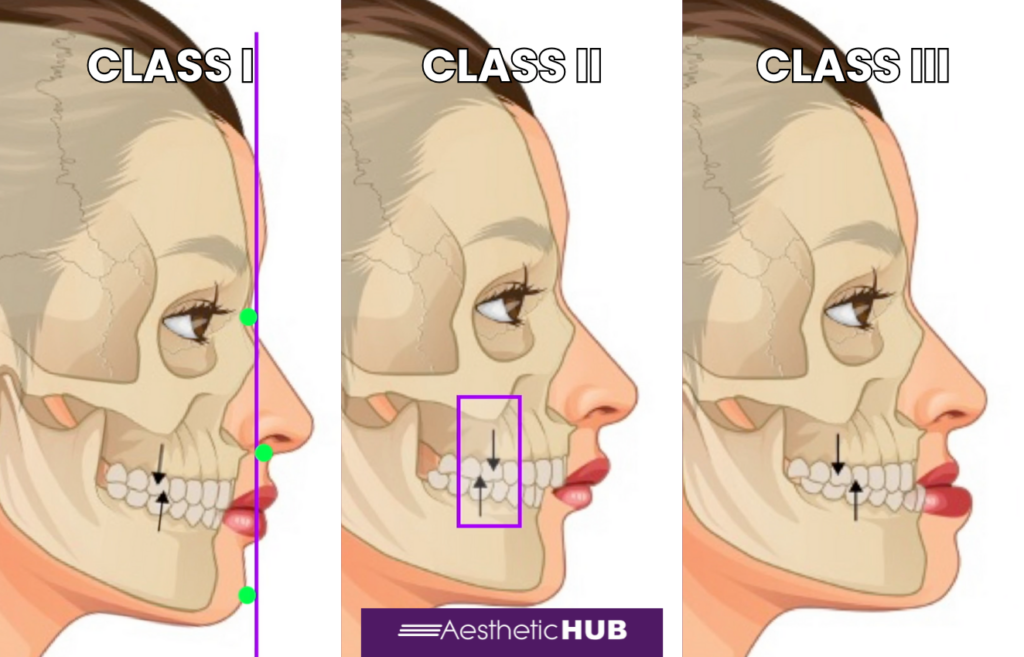
Frankfort-Mandibular Planes Angle (FMPA)
- The Frankfort plane runs from the ear canal to the lowest point of the orbital rim
- The mandibular plan follows the lower border of the mandible
- The intersection of these planes reveals whether the patient has a normal (average 28°), high, or low angle profile
- This angle significantly impacts how patients age and how they respond to treatments
Facial Profile Lines
- Ricketts’ E-line: Drawn from the tip of the nose to the tip of the chin. Ideally, the upper lip should lie 4mm behind this line and the lower lip 2mm behind.
- Steiner S-line: Connects the soft-tissure pogonion and the midpoint between the subnasale and nasal tip. The lips should touch this line.
- Nasolabial angle: The angle between the nasal columella and upper lip slope, typically 85-120°
- Labiomental angle: The relationship of the lower lip to the chin, usually 110-130°
Understanding these profile measurements help identify whether aesthetic concerns stem from skeletal discrepancies or soft tissue deficiencies. This distinction is crucial, as some issues require surgical intervention rather than injectable treatment.
Facial Symmetry: Perfect Imperfection
The human face is naturally asymmetrical, with slight discrepancies making faces appear more natural. Assess symmetry by drawing a median sagittal line from the middle of the philtrum to the glabella. If differences between the face halves aren’t noticeable at first glance, reassure the patient their face is appropriately symmetrical.
Remember that symmetry is affected by all facial layers – from bone to skin – and becomes even more complex in motion. Small asymmetries will persist regardless of treatment success.
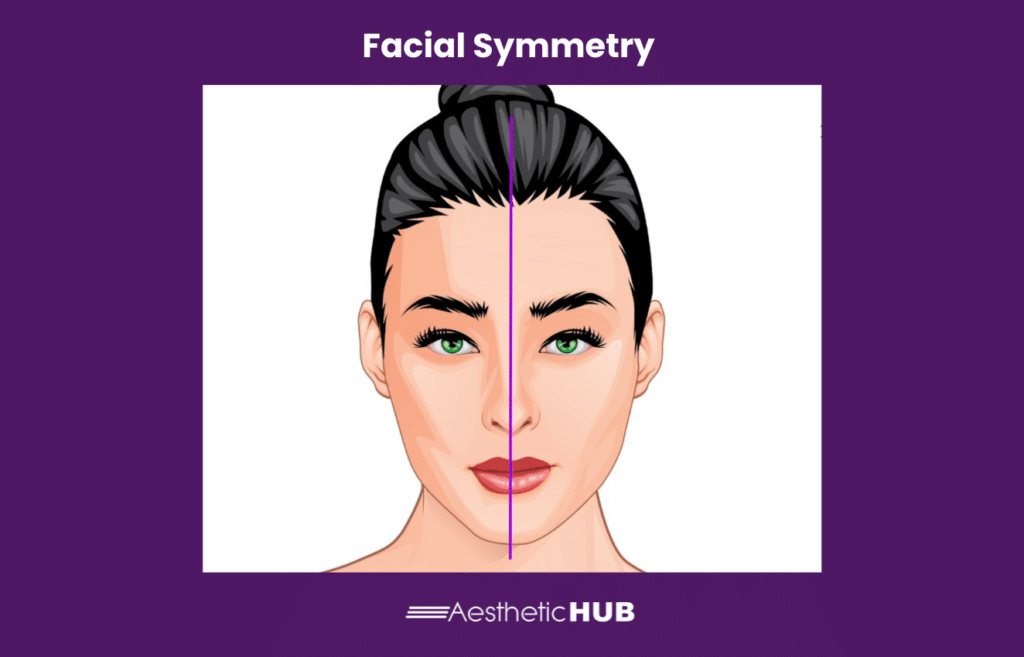
Putting It All Together
When conducting a facial assessment, follow these steps:
- Identify the patient’s face type
- Evaluation general proportions visually
- Assess vertical proportions (rule of thirds)
- Assess horizontal proportions (rule of fifths)
- Evaluate the profile (skeletal class and FMPA)
- Examine the lower face in profile (E-line/S-line, nasolabial angle, labiomental angle)
- Assess facial symmetry
How much of this assessment you conduct depends on the case complexity and treatment area. For comprehensive treatments, this thorough assessment is invaluable. For simpler procedures, you might focus on specific areas, but keeping the overall principles in mind helps you make appropriate recommendations for patients.

Learn From The UK’s Best Injectors
Mastering facial assessment is essential for medical professionals entering aesthetic medicine. At the Smileworks Aesthetic Training HUB, we equip practitioners with the knowledge and skills needed to create beautiful, balanced results that enhance a patient’s unique features.
For beginner injectors, the best starting point is our Botox & Lip Filler course. You’ll learn all of the basics to start a flourishing aesthetics practice. All of our courses are designed specifically with medical professionals like doctors, dentists, and nurses in mind. You’ll walk away with the skills and knowledge necessary to start practicing on real patients right away.
Already have some injecting experience under your belt? Look no further that our Foundation Facial Ultrasound Course and our Advanced Facial Ultrasound Course, two musts for injectors who care about patient safety. Ultrasound is the single most important too for ensuring safe and effective treatments every time.
For those looking for more in-depth training, we recommend booking a one-to-one mentoring session with Dr MJ. These sessions at 100% customisable, and you’ll receive personalised instruction based on your skill level and goals.
It’s time to embrace the prospering world of aesthetic medicine. The HUB provides you with all the right training and guidance you need to succeed. Take control of your professional journey and step into a future filled with endless potential and opportunities.
Join us at the HUB. Let’s shape the future of aesthetic medicine together and ensure safe, effective, and transformative results for every patient.
Want to try out our courses before committing? Take advantage of our free trial for a taste of what learning at the HUB is like.
